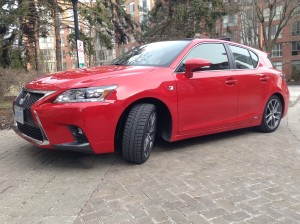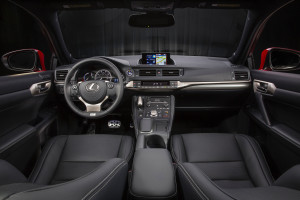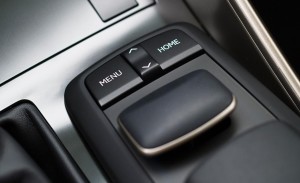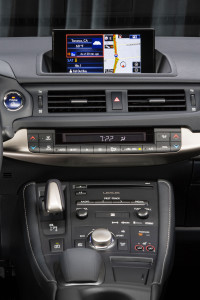Lexus (and parent company Toyota) are no strangers to hybrid vehicles. A quick look at the Lexus lineup shows hybrid options for many of the vehicles it produces, plus a hybrid that has no regular gasoline-motor-only equivalent: the Lexus CT 200h.

First impressions
My Redline with Black Roof tester is more than the Toyota Prius stablemate it most closely resembles. It features the F Sport front grill and rear spoiler, among other sporty exterior touches.
Interior
The black interior comes off understated and classy. Aluminium sport pedals with rubber inserts stand out against the black floor mat.

photo courtesy Lexus
Lowering the seat and sliding back the inside of the power sunroof gave me just enough room to sit up (almost) straight, and I got used to the feeling of the ceiling touching my head as I drive.
Lexus thoughtfully links side mirror positions to the three driver’s seat memory settings it offers on the door.
The trunk is shallow, given how the battery sits just under the trunk floor behind the rear seat and a spare tire lies between the battery and the rear bumper. The roll-back cargo cover neatly got out of the way when, well, I had to load this.

In-car technology
I accesses the optional 10-speaker sound system and other systems in my tester using the Lexus Display Audio system. The system obeyed commands from the Remote Touch Knob, a rectangular combination moveable joystick and button, plus the buttons just ahead of the knob.

Lexus placed a leather pad just ahead of the controller where my hand rested as I moved and clicked the controller. This pad and controller combination reminds me of using a computer trackball I had more than a decade ago. Thanks to this setup, bumps in the road didn’t make me miss selections the way I might have if I used a touchscreen instead.
The moveable controller moves the crosshairs on the screen. Move the controller all the way to the top left corner and that’s where the crosshairs end up. The system highlights anything “clickable” the crosshairs approach. It also “clicks into place” when the on-screen pointer lands on something that you can click by pressing the knob. This means, for instance, that it “clicks” more often on a screen that contains a keyboard than it does on a map. This haptic feedback makes the knob/screen an intuitive and comfortable system to maneuver.
The rest of the controls in the centre stack are intelligently laid out and straightforward to use. I particularly appreciated not having to go to a touch screen to use climate controls. Settings appear on a screen just above the climate control buttons.
Seat heaters are controlled using pop-out knobs I recall from audio systems in the ‘90s and have rarely seen since. Again, this is a good thing – the simpler commonly used controls are to use, the better. You can control just about all this stuff using the screen as well, but physical buttons and knobs are much easier to use when the vehicle is in motion.

photo courtesy Lexus
Audio
The CT 200h offers all the usual suspects, including satellite radio, one CD player, USB inputs and Bluetooth pairing for mobile devices.
As in other cars I’ve tested, the Lexus system does not handle Overdrive well. Overdrive is a “library” app that I use to (among other things) download and listen to audiobooks. It doesn’t get along very well with most automotive audio systems I’ve tried, though I can usually get it to work with a little futzing. I look forward to using it via CarPlay instead of manufacturer-specific systems. That’s the day when Lexus (and other carmakers) will turn over curation of mobile apps to the mobile OS companies (Apple and Google) who are best equipped to perform this curation.
(After I returned the CT 200h, Overdrive updated the mobile app. I’ll test it in other vehicles and relate my findings in reviews of those vehicles. Still, I don’t think automakers should be in the business of app curation. As I wrote above, that job is best done by mobile device operating system developers, a.k.a. Apple and Google.)
Driving
A 1.8 litre, 4-cylinder engine combines with an electric motor to push net system power of 134 hp through the CT 200h’s continuously variable transmission. This car isn’t a screamer by any stretch, but it moves sufficiently well.
A drive mode knob on the centre console lets you get more oomph out of the engine. Twist it to the right, the light under it changes from blue to red, the left dial on the instrument cluster becomes a tachometer and you’re in Sport Mode.
To dial the CT 200h down to Eco mode, turn the dial to the left. The left dial on the instrument cluster reverts to the “charge/eco/power” gauge. The car achieves better mileage using measures like curbing air conditioning. Driver who seek a happy medium between Eco and Sport need only push the dial to return to “normal” drive mode.
There’s an EV button near the drive mode knob. It will let you creep quietly through parking lots and other low-speed zones using just the electric motor. Pick up too much speed and the CT reverts to your previous drive mode.
Passive safety features abound, and they’re complimented by technology meant to keep them from having to activate. Vehicle Stability Control, the Traction Control System and Hill-Start Assist Control all help drivers behave at the wheel.
Dynamic radar cruise control is an option my tester didn’t have.
Mileage
The CT 200h, like other hybrids, skews opposite to ordinary single-motor cars, delivering 5.5 L/100km in the city and 5.9 on the highway. This car takes 87 octane fuel in its 45-litre tank.
Pricing
The Lexus CT 200h starts at $31,650 MSRP. Options of $9,000, grouped under the F Sport Series 2 package, plus taxes and fees made the car as tested $42,826.97.